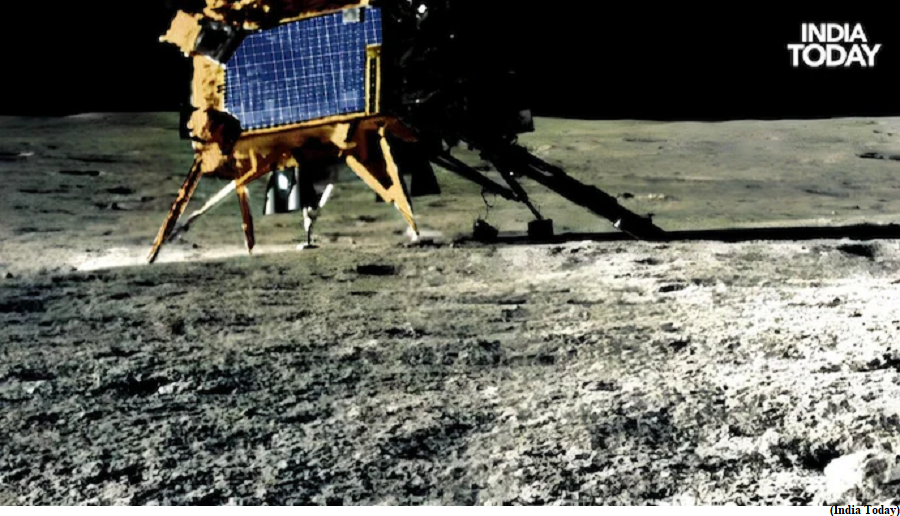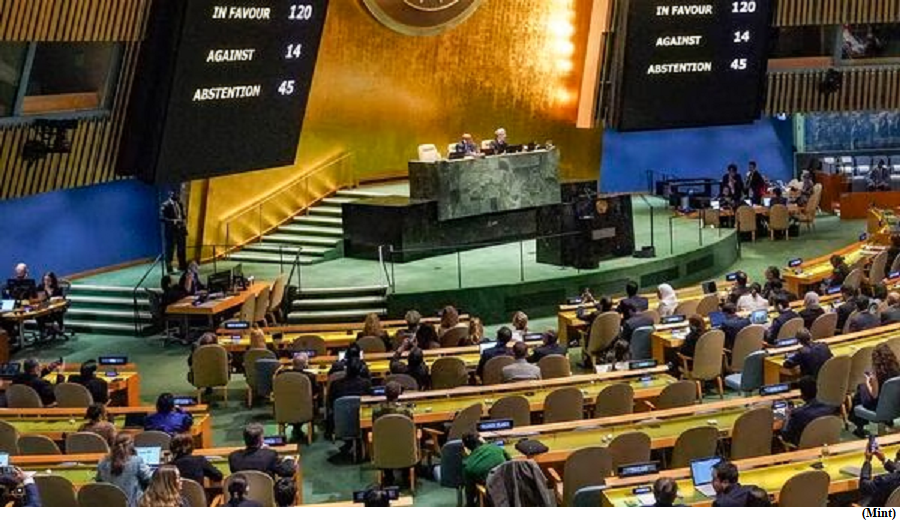Chandrayaan 3 blasted away 2.06 tonnes of lunar soil as it landed on Moon (GS Paper 3, Science and Technology)

Why in news?
- The Indian Space Research Organisation recently revealed that lander Vikram displaced approximately 2.06 tonnes of lunar regolith (rocks and soil) as it landed on the surface of the Moon.
Chandrayaan-3 mission:
- Chandrayaan-3 made a historic landing on the moon on August 23. The lander module, named Vikram, and the rover, Pragyan, touched down on the Shiva Shakti Point in the South Polar Region of the Moon.
- The Chandrayaan-3 mission is a follow-up to the Chandrayaan-2 mission and aims to demonstrate end-to-end capability in safe landing and roving on the lunar surface.
- The mission objectives include achieving a safe and soft landing on the lunar surface, demonstrating the rover's mobility on the Moon, and conducting in-situ scientific experiments.
- The successful landing of Chandrayaan-3 near the moon's south pole makes India the first country to achieve this feat.
Ejecta halo:
- As it descended, the Chandrayaan-3 Lander Module generated a spectacular 'ejecta halo' of lunar material. This phenomenon was captured and analyzed by scientists from the National Remote Sensing Centre (NRSC), a part of ISRO.
- According to their findings, approximately 2.06 tonnes of lunar epiregolith, or surface material, were ejected and displaced over an area of 108.4 square meters around the landing site.
- Scientists compared the pre- and post-landing high-resolution imagery from the Orbiter High-Resolution Camera (OHRC) of the Chandrayaan-2 orbiter.
- The images were acquired hours before and after the landing event, which characterised this ‘ejecta halo’ appearing as an irregular bright patch surrounding the lander.
Significance:
- The study, titled "Characterisation of Ejecta Halo on the Lunar Surface Around Chandrayaan-3 Vikram Lander Using OHRC Imagery", provides valuable insights into the impact of lunar landings on the moon's surface.
- ISRO had to wait for some time for the lunar soil kicked off by the thrusters to settle down before they could roll out the Pragyan rover on the surface of the Moon.
The UNGA vote on Gaza war, and why India abstained
(GS Paper 2, International Relation)
Why in news?
- India abstained in a UN General Assembly vote on a resolution that called for an immediate humanitarian truce in the Israel-Hamas conflict.
- The resolution, which does not contain the words ‘Hamas’ and ‘hostage’, was carried with 120 votes in favour and 14 against.

Details:
- Before this vote, an amendment to the text proposed by Canada, naming Hamas, was rejected because it failed to get the support of two-thirds of members present and voting. India voted in favour of this amendment, along with 86 other nations.
- India’s abstention in the vote exemplified the balancing act it has adopted on the ongoing conflict in the Gaza Strip.
Key takeaways:
Protection of civilians and upholding legal and humanitarian obligations:
- India joined Australia, Canada, Germany, Japan, Ukraine, and the United Kingdom in the group of 45 countries that abstained on the resolution titled “Protection of civilians and upholding legal and humanitarian obligations”.
- The resolution, which called for an “immediate, durable and sustained humanitarian truce leading to a cessation of hostilities” and unhindered humanitarian access to the Gaza Strip, was drafted by a group of 22 Arab countries and was proposed by Jordan, which has been vocal in its criticism of the Palestinians civilian casualties in the Israeli bombardment.
- Among the co-sponsors of the resolution were Bangladesh, Maldives, Pakistan, Russia, and South Africa.
- Israel, the United States, five small Pacific island nations, and four Eastern European countries; Austria, Croatia, Czechia, and Hungary were among the 14 members who voted against the resolution.
- Jordan said a vote against the resolution would amount to approving a “senseless war” and “senseless killing”, while Israel rejected the vote as “infamy”.
Fixing the responsibility of Hamas in the crisis:
- The amendment proposed by Canada and co-sponsored by the US, sought to fix the responsibility of Hamas in the crisis.
- The amendment asked for the insertion of a paragraph in the resolution that would state that the General Assembly “unequivocally rejects and condemns the terrorist attacks by Hamas that took place in Israel starting on 7 October 2023 and the taking of hostages, demands the safety, well-being and humane treatment of the hostages in compliance with international law, and calls for their immediate and unconditional release”.
- India went with the majority (87) on this vote, while 55 member states voted against it, and 23 abstained. The President of the 78th session of the UNGA, Dennis Francis, announced that the draft amendment could not be adopted.
Outcome of resolutions:
- Unlike resolutions of the UN Security Council, resolutions of the UNGA are not legally binding.
- Therefore, despite the comprehensive defeat, Israel and the US are not obliged to act on the resolution. However, the resolution carries “incredible weight and moral authority”.
India’s approach:
- The balanced position taken by India was in line with the one that it has maintained in the other ongoing and deeply polarising conflict in the world: the Russia-Ukraine war.
- While the circumstances, politics, and conditions of the two wars are vastly different and not comparable, the diplomatic toolkit of hedging and balancing between the warring sides has been a consistent feature of India’s approach.
- This is the approach that carried the day during the consensus-building exercise at the G20 Summit as well.
- However, the geopolitics of the Middle East are both more volatile and complicated, as well as closer home and India will need to mobilise all its diplomatic skills and goodwill with the main actors to negotiate the coming weeks and months.



